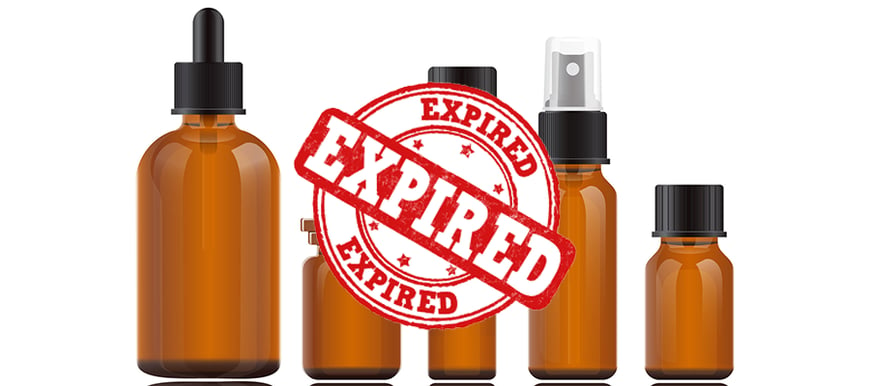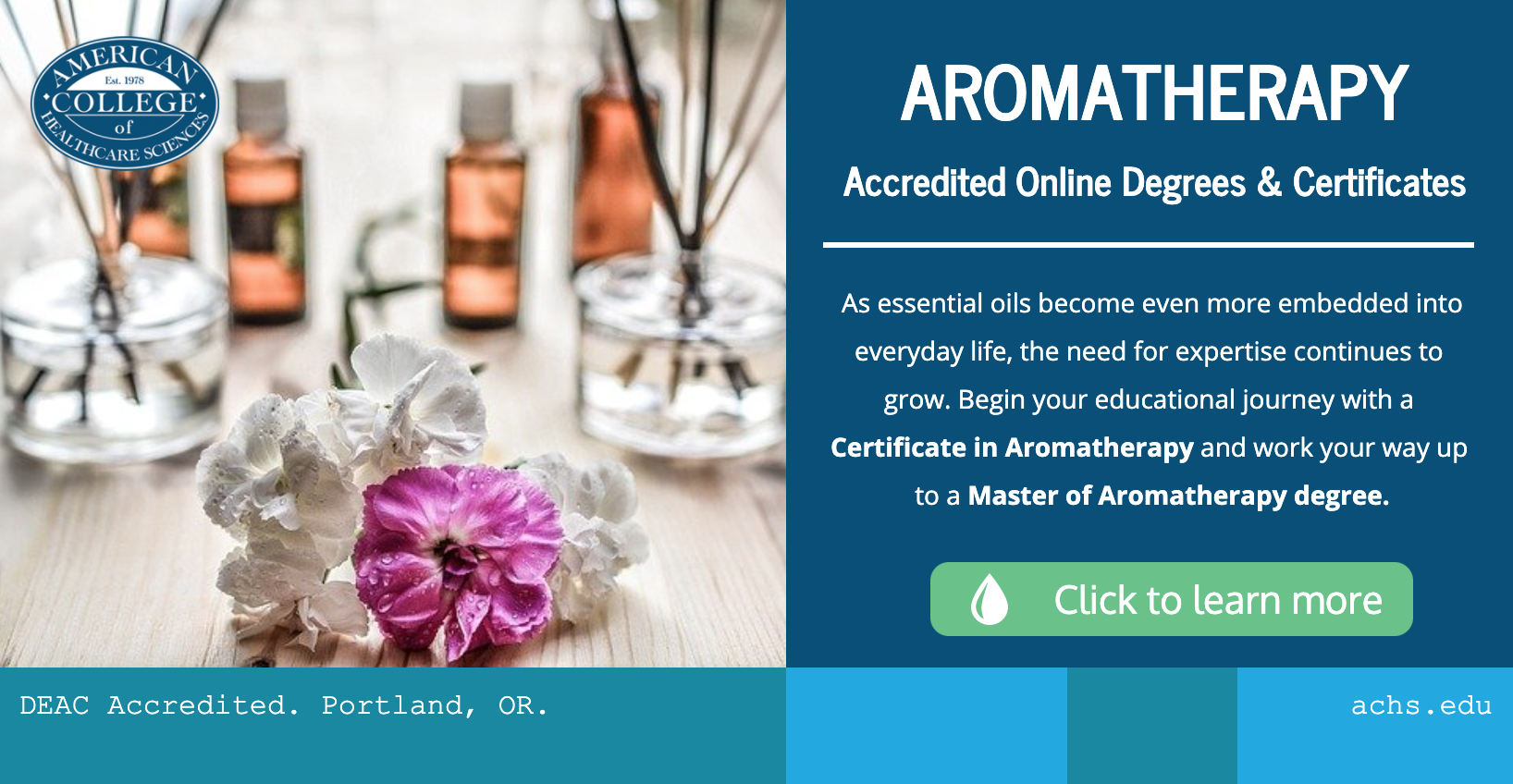Shelf Life: How to Avoid the Dangers of Expired Oils
Image Copyright: ninadolgopolova & Balint Roxana / 123RF Stock Photo
Education is the best way to protect yourself from the potential dangers of expired natural beauty products. Aromatherapy science tells us that essential oils and base oils used for blending have a shelf life. There is an ideal window of opportunity to use these products when they are healthy and robust.
Have you ever opened a bottle of expensive, certified organic sweet almond oil that has been sitting in your warm cupboard or on a sunny shelf for a few years? Did you notice it has a weird, “off” odor?
From the moment a fresh seed, nut, or fruit is pressed to release the fixed oil trapped inside, the onslaught begins. The ravages of the elements start the process known as oxidation, which leads to rancidity.
Oxygen is one of the main culprits. A base oil exposed to oxygen is a helpless victim, although some are sturdier than others. Oxygen molecules hungrily grab the double bonded carbons in the oil and furtively steal a carbon to make a carbon-oxygen bond.
And, just like that … wham! …the process of degradation begins. Add light and heat to the oxygen, and now we have a gang. That sweet almond oil that took many fresh almonds to produce easily succumbs. That weird off note now just smells “yuck”! It is oxidized and rancid.
All base oils will experience this onslaught if they are not protected from oxygen, light, and heat. It can also occur with essential oils. The essential oils will start to change in composition from the moment they are released from the plant during the magical process of steam distillation. This is a natural consequence of time and conditions.
For base oils and most essential oils, once harvested from the plant and distilled, the clock starts ticking. Why? The certified organic and sustainably wildcrafted oils you want to use should not have not been cut with any preservatives. In essence (pun intended!), they are pure.
Why do high-quality essential oils expire?
Essential oils are chemically complex. Their health benefits, or therapeutic actions, are the result of the active constituents in the distilled essential oil like monoterpenes, sesquiterpenes, monoterpenoids, and sesquiterpenoids. Unfortunately, when monoterpenoids and sesquiterpenoids come in contact with the air, they oxidize, as we’ve mentioned.
You can learn in-depth about the chemical process in our post, Debunking Dangerous Myths About Essential Oils. But for now, it’s enough to know that the process is similar to what happens when wine is exposed to air—it turns to vinegar. Essential oil constituents are unsaturated compounds, chemical compounds that contain carbon-carbon double bonds or triple bonds. This allows them to spoil or oxidize.
But, there are a few exceptions to this rule. Patchouli Pogostemon cablin (Blanco), sandalwood Santalum spp., vetiver Chrysopogon zizanioides (L.), and ylang ylang Cananga odorata (Lam.) var. genuina do not spoil over time if stored correctly and can actually improve with age. Again, these oils are the exception, not the rule.
So, how long do essential oils last?
The shelf life of essential oils varies. It can depend on the temperature they are stored at and their exposure to light and oxygen. Oxidation occurs much faster at higher temperatures and with greater exposure. Ideally, you want to store your essential oils in a cool, dark place, in a full glass or food-grade aluminum bottle with a tight-fitting lid. You can even store them in the refrigerator, which is specifically recommended for citrus oils because they are more susceptible to oxidation; typical shelf life for citrus oils is nine months to one year.
In general, to be on the safe side, replace your essential oils after three years, with the exception of patchouli P. cablin, sandalwood S. spp., vetiver V. zizanioides, and ylang ylang C. odorata var. genuina oils. Again, these four get better with age. Don’t waste your older essential oils though as they make great cleaning products once diluted.
Here’s a great video from ACHS president and aromatherapy expert, Dorene Petersen, on how to properly store your essential oils:
How do I recognize expired or oxidized essential oils?
On occasion, oxidation can render the aroma of an essential oil rather unpleasant. Citrus essential oils and oils high in limonene, like grapefruit Citrus paradisi (Macfad.) and lemon Citrus limonum (Risso), are good examples.
But, in most cases, oxidation won’t be quite as obvious.
This is where you will want to use your all your senses, also known as organoleptic skills. You’ll want to look for changes in both the aroma and viscosity of the essential oils. An essential oil can also change color and usually darkens; some oils like chamomile Roman Chamaemelum nobile (L.) All. and German Matricaria recutita (L.) and yarrow Achillea millefolium (L.) can even change from blue to brown. Peppermint Mentha xpiperita (L.) var. vulgaris can go a greenish color. So, smell, feel, look, and for some essential oils (like the citrus oils), taste; put a drop on your finger and give it a taste. Once you have organoleptically experienced freshly distilled oils, an oxidized oil will be obvious.
What are the dangers of using expired or oxidized essential oils?
Aside from patchouli P. cablin, sandalwood S. album, vetiver V. zizanioides, and ylang ylang C. odorata var. genuina as mentioned above, oxidation degrades essential oils’ aromatic and therapeutic properties. Spoilage can also result in irritation or sensitization, which can cause skin rashes, burns, peeling skin, or other unpleasant side effects. For example, tea tree Australia Melaleuca alternifolia (Cheel) and New Zealand Leptospermum scoparium (Forst.) and lavender Lavandula angustifolia (Mill.) can cause irritation if they are oxidized. You can read more about the symptoms of, and differences between irritation and sensitization in our previous post, Essential Oil Safety: Practicing Aromatherapy with Caution.
Do high-quality base oils expire, too?
Base oils are used to dilute essential oils for topical use, such as for massage blends, bath blends, aromatic blends, or body scrubs, among others. Always use a high-quality, cold-pressed or unrefined vegetable, nut, or seed oil—such as almond, jojoba, grapeseed, argan, camellia, rose hip, or safflower oil—with either a single essential oil or a blend of oils selected for a specific therapeutic purpose. Base oils can also be used to dilute essential oils to create culinary extracts.
Remember, pure, unrefined oils do not include preservatives; they have a natural shelf life like essential oils. Here’s a chart of the storage requirements for some of the most commonly used base oils:
Base Oil |
Storage Requirements |
|
Avocado |
Stores well if kept cool. If it becomes chilled, the constituents will precipitate and it will become cloudy. If this occurs, gentle warming to room temperature will improve its clarity. |
|
Camellia |
Store at cool temperature in a well-filled, airtight container protected from the light. |
|
Coconut |
It will become rancid if exposed to air. Store at a cool temperature in a well-filled, airtight container protected from light.
|
|
Evening Primrose |
Relatively unstable. Store in a well-filled, airtight container in a cool temperature (less than 40°F), protected from light.
|
|
Grapeseed |
It keeps well, but needs to be stored away from sunlight and heat. |
|
Hazelnut |
Keeps well, but needs to be stored away from sunlight and heat. |
|
Kukui Nut |
Store in opaque, well filled, airtight containers at 68°F or below. |
|
Jojoba |
Stable. It is very long lasting and does not become rancid if it is not decolorized. Ideal storage temperature should not exceed 50˚F. |
|
Olive |
Store at cool temperatures in well-filled, airtight containers protected from the light. |
|
Rosehip Seed |
Relatively unstable. Store in a well-filled, airtight container in a cool temperature, protected from light. |
|
Safflower |
Thickens and becomes rancid with prolonged exposure to air. |
|
Sunflower |
Store in a well-filled, airtight container at a cool temperature (less than 40°F), protected from light. |
How do I keep my base oils from expiring?
Ideally, store your cold-pressed base oils in dark bottles in the refrigerator. This will help to keep them as fresh as possible. But, base oils can become rancid over time, whether stored in the fridge or not. It’s best not to buy base oils in bulk unless you know you use a large quantity on a regular basis.
Vegetable oils, like olive and sunflower, need a little extra attention. Store them in a cool place or they can easily oxidize and turn rancid.
In natural cold-pressed oils, the vitamin E will protect the oil from rancidity to some extent, but it will still oxidize given enough time or when exposed to light, heat, or air for too long. In refined oils, the vitamin E is destroyed or removed and a chemical antioxidant added. Avoid refined oils because of their chemical content.
How do I recognize rancid base oils?
Rancid base oils will typically have a putrid, strong, or sour smell, but not always. Some oils, like coconut oil, will even change color (coconut oil will turn yellow). Unfortunately, there’s no foolproof way to tell if your oil is truly fresh. It’s best to follow the proper storage guidelines above and use up your base oils before the shelf life expires.
What are the dangers of using rancid base oils?
Rancid oils pose more risk than a stinky smell. They can be toxic.[1] When fresh, many oils like coconut oil contain antioxidants, which scrub harmful free radicals from the body. But when oil goes rancid, it has the opposite effect. Rancid oils can increase the amount of free radicals in the body, which can damage cells and encourage diseases like cancer, diabetes, and more.
Moreover, eating rancid oil can possibly deplete your vitamin E and vitamin B levels. And if that’s not enough to convince you to keep your base oils fresh, rancid oils can contain potentially toxic compounds that can lead to diseases like heart disease, accelerated aging, and even cancer.[2] According to holistic health sage Dr. Andrew Weil, rancid oils are “carcinogenic, pro-inflammatory, and very toxic.”[3]
How do I learn more about aromatherapy and quality oils?
If all this talk about terpenes, shelf life, antioxidants, and essential oil quality has you clamoring for more, you’re in the right place. You can start by feeding your aromatherapy cravings with our essential oil safety blog series. And if you’re really ready to get elbows deep in essential oils (JK… that wouldn’t be safe), check out our accredited, online certificates, diplomas, associate and master degrees in aromatherapy.
Disclosure of Material Connection: This blog may contain affiliate links. I am disclosing this in accordance with the Federal Trade Commission’s 16 CFR, Part 255: “Guides Concerning the Use of Endorsements and Testimonials in Advertising.
This article is for informational purposes only. It is not intended to treat, diagnose, cure, or prevent disease. This article has not been reviewed by the FDA. Always consult with your primary care physician or naturopathic doctor before making any significant changes to your health and wellness routine.
[1] Totani, Nagao, Burenjargal, Munkhjargal, Yawata, Miho, Ojiri, & Yuko. (2008). Chemical properties and cytotoxicity of thermally oxidized oil. Journal of Oleo Science, 57(3). 153-60. doi: 10.5650/jos.57.153. Retrieved from https://www.researchgate.net/publication/5582569_Chemical_Properties_and_Cytotoxicity_of_Thermally_Oxidized_Oil
[2] Eng, M. (7 March 2012). “Has your food gone rancid? Consumers may have kitchen full of dangerous products and not know it.” Chicago Tribune. Retrieved from http://articles.chicagotribune.com/2012-03-07/features/sc-food-0302-rancidity-20120307_1_trans-fats-polyunsaturated-oils-food-chain
[3] Ibid.







